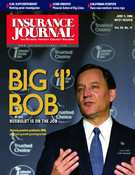News Currents
California Insurance Commissioner John Garamendi has released a new report, “Lower Claims, Higher Profits: Where Do Your Premium Dollars Go?” on the profitability of homeowners and private passenger automobile insurance companies. According to the Commissioner’s office, “the study discloses that for the past two years, insurance companies have enjoyed a scenario in which the amount they pay for claims has dwindled, while the money they keep has soared.”
The study says that beginning in 2004, loss ratios dropped precipitously in the homeowners’ insurance market in California. Most of the loss ratios for the top 20 carriers in California were well below 50 percent, it says.
A loss ratio measures the relationship between the dollars paid out in claims and other loss expenses to the premium dollars received from policyholders.
In the private passenger auto market between 2002 and 2003, loss ratios declined for 18 of the top 20 carriers in the state. Between 2004 and 2005, half of the top 20 carriers saw declining loss ratios in their automobile liability coverage. The large majority of companies had loss ratios in the 50 percent to 60 percent range, yet in 2004 and 2005, rates had not been reduced by most carriers, the study indicates.
“Low loss ratios can be the result of better underwriting, better risk selection or better luck, as well as excessive premiums,” the study says. “But certain trends in data support the inference that a decreased loss ratio can be the result of too high a premium level. For instance, an insurance company might have a lower loss ratio when it fails to reduce its rates despite decreased losses. This is especially true if it had previously raised its rates when losses increased.”
The Commissioner has scheduled a hearing for July 20, at which he will examine the issue.
“For the past two years homeowners and automobile insurance companies in this state have profited immensely at the expense of consumers. A new study from my office shows that the more money these companies keep from your premiums, the less they pay out in claims. In my view, Californians are due for a break. If my understanding of these results is confirmed by my full review and hearing, I am confident that I will be ordering a significant number of insurers to reduce their rates,” Garamendi said in a statement.
“As we embark upon this task, bear in mind that the insurance industry bitterly opposes my latest effort to rein in pricing and bring affordable, fair insurance to all,” he continued. “My new pricing reforms would require insurers to base auto insurance rates primarily upon how safely you drive, and not just where you live. The rules would reward good drivers and end the industry’s practice of punishing safe drivers with high premiums simply because they live in the ‘wrong’ ZIP code. The industry recently unleashed a $2.4 million advertising campaign attacking me and these reforms. The shady methods they employed in a failed attempt to intimidate me into delaying the reforms demonstrate the lengths to which they will go to protect this extraordinarily profitable market they currently enjoy.
“I am interested in seeing a healthy and prosperous insurance industry in California,” he added. “But at the same time, the law requires that insurance company profits not be excessive. California voters have entrusted me with the responsibility of assuring that the premiums California home-owners pay are used to pay claims and provide a reasonable profit.
“In my view, some of the low loss ratios we are witnessing are an indication that profits and rates are excessive, and that consumers should be paying lower premiums,” he said.
Garamendi said his July hearings will help to determine whether the rates consumers are paying are excessive, and whether he should order insurers to lower their rates.
Referring to the private passenger auto market, Garamendi said, “While the case for excess profits is not as clear in the private passenger automobile insurance market, we must continue to be vigilant to ensure that these companies do not overcharge customers as their financial position continues to improve. We will review rates for the private passenger automobile market as we implement changes to our auto rating factors reforms. As I mentioned earlier, these changes to current practice are designed to ensure that premiums for auto insurance are based more upon how safely a person drives, than where the person lives. I believe that these companies are financially strong enough, and the rates they have been charging are high enough, that no consumer should have to bear an undue burden as we transition to the new rating methodologies.”
For the study, CDI reviewed the loss ratios of the top 20 insurance companies that sell homeowner and private passenger automobile insurance in the state. The premium volume for the group represented approximately 83 percent of the homeowner insurance sold in the state, and approximately 80 percent of the private passenger automobile sold in California.
Topics California Carriers Auto Profit Loss Excess Surplus Homeowners Market
Was this article valuable?
Here are more articles you may enjoy.


 California Chiropractor Sentenced to 54 Years for $150M Workers’ Comp Scheme
California Chiropractor Sentenced to 54 Years for $150M Workers’ Comp Scheme  Former Congressman Charged After Collision with State Trooper in Florida
Former Congressman Charged After Collision with State Trooper in Florida  Coral Gables, Florida Tops Beverly Hills as Ritziest Home Market in US
Coral Gables, Florida Tops Beverly Hills as Ritziest Home Market in US  Trump’s Bond Insurer Tells Judge Shortfall Is ‘Inconceivable’
Trump’s Bond Insurer Tells Judge Shortfall Is ‘Inconceivable’ 


